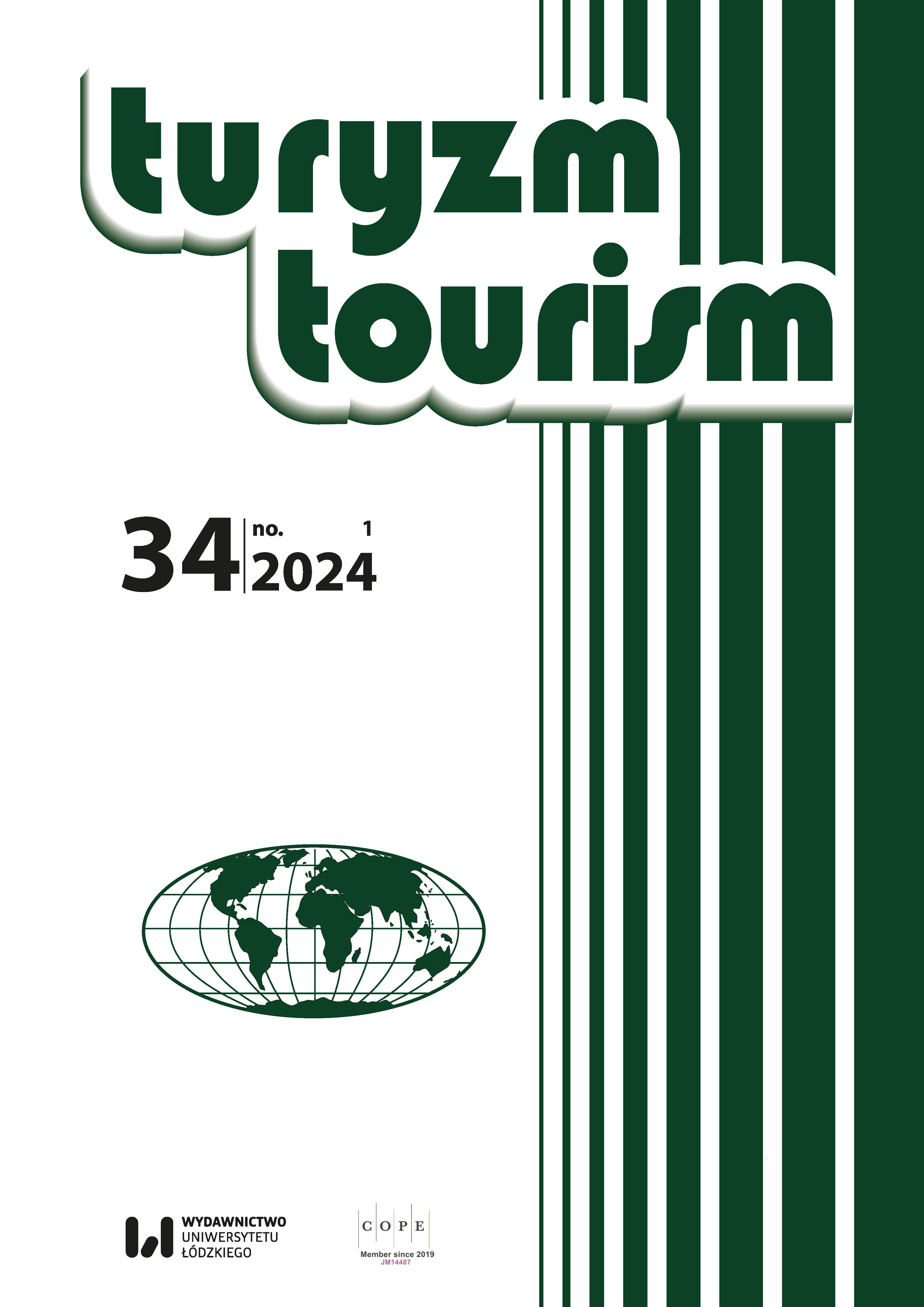Digital mapping of tourism destinations in Bangka Regency based on the wellness tourism model
DOI:
https://doi.org/10.18778/0867-5856.34.1.06Keywords:
wellness tourism, scalogram analysis, tourism destinationAbstract
In the dynamic landscape of global tourism, a notable shift has occurred with the rising importance of wellness tourism. This research aims to systematically identify and evaluate tourism destinations within Bangka Regency that have successfully implemented indicators of the wellness tourism model. The study employs scalogram analysis to assess the service capacity of these destinations for visitors, considering factors such as accessibility, facilities, attractions, destination cleanliness and the implementation of health protocols. The findings reveal a nuanced categorization of destinations into five groups. From the 14 samples, approximately 34.71% of the destinations exhibit extensive facilities (I), while 14.29% possess satisfactory (II), another 14.29% have adequate (III) and again of 14.29% have destinations with less than adequate (IV). Furthermore, 21.42% of the destinations are characterized by insufficient (V). The identified groupings offer insights for policymakers, stakeholders and businesses to enhance wellness tourism experiences, thereby contributing to the overall development of the tourism sector in the region.
Downloads
References
Badan Pusat Statistik. (2021, December). The number of hotel guest visits to the Province of the Bangka Belitung Islands in December 2021 was 48,086 visits. BPS Bangka Belitung Province. https://babel.bps.go.id/pressrelease/2022/02/02/891/jumlah-kunjungan-tamu-hotel-ke-provinsi-kepulauan-bangka-belitung-desember-2021-sebesar-48-086-kunjungan-.html
Google Scholar
Chen, K.-H., Chang, F.-H., & Tung, K.-X. (2014). Measuring wellness-related lifestyles for local tourists in Taiwan. Tourism Analysis, 19(3), 369–376. https://doi.org/10.3727/108354214X14029467968682
Google Scholar
DOI: https://doi.org/10.3727/108354214X14029467968682
de la Barre, K., de la Barre, S., & Taggart, M. (2005, May). A feasibility study for a Yukon health and wellness industry. North to Knowledge, Learning Travel Product Club, and The Department of Tourism and Culture, Yukon Territorial Government. https://silo.tips/download/a-feasibility-study-for-a-yukon-health-and-wellness-tourism-industry
Google Scholar
Han, H., Kiatkawsin, K., Koo, B., & Kim, W. (2020). Thai wellness tourism and quality: Comparison between Chinese and American visitors’ behaviors. Asia Pacific Journal of Tourism Research, 25(4), 424–440. https://doi.org/10.1080/10941665.2020.1737551
Google Scholar
DOI: https://doi.org/10.1080/10941665.2020.1737551
Ismiwati, B., & Sayuti, M. (2019). Penentuan pusat-pusat pertumbuhan dan wilayah pendukungnya sebagai upaya pengembangan wilayah di Kabupaten Lombok Barat, Nusa Tenggara Barat. Jurnal Kompetitif: Media Informasi Ekonomi Pembangunan, Manajemen dan Akuntansi, 5(2), 69–82. https://e-journal.unizar.ac.id/index.php/kompetitif/article/view/149
Google Scholar
Khuong, M.N., & Phuong, N.T. (2017). The effects of destination image, perceived value and service quality on tourist satisfaction and word-of-mouth: A study in Ho Chi Minh City, Vietnam. International Journal of Trade, Economics and Finance, 8(5), 217–224. https://doi.org/10.18178/ijtef.2017.8.5.568
Google Scholar
DOI: https://doi.org/10.18178/ijtef.2017.8.5.568
Luthfiani, A.D., & Suryani, A.W. (2022). The impact of voluntary and involuntary intellectual capital disclosure on firm value. The Indonesian Journal of Accounting Research, 25(1), 49–82. https://doi.org/10.33312/ijar.593
Google Scholar
DOI: https://doi.org/10.33312/ijar.593
Mueller, H., & Kaufmann, E.L. (2007). Wellness tourism: Market analysis of a special health tourism segment and implications for the hotel industry. Journal of Vacation Marketing, 7(1), 5–17. https://doi.org/10.1177/135676670100700101
Google Scholar
DOI: https://doi.org/10.1177/135676670100700101
Nandya, A.F. (2016). Identifikasi pusat pertumbuhan dan wilayah hinterland di Kabupaten Sleman. Universitas Islam Indonesia. https://dspace.uii.ac.id/handle/123456789/5996
Google Scholar
Nawijn, J., & Filep, S. (2016). Two directions for future tourist well- being research. Annals of Tourism Research, 61, 221–223. https://doi.org/10.1016/j.annals.2016.07.007
Google Scholar
DOI: https://doi.org/10.1016/j.annals.2016.07.007
Page, S.J., Hartwell, H., Johns, N., Fyall, A., Ladkin, A., & Hemingway, A. (2017). Case study: Wellness, tourism and small business development in a UK coastal resort: Public engagement in practice. Tourism Management, 60, 466–477. https://doi.org/10.1016/j.tourman.2016.12.014
Google Scholar
DOI: https://doi.org/10.1016/j.tourman.2016.12.014
Pandža Bajs, I. (2015). Tourist perceived value, relationship to satisfaction, and behavioral intentions: The example of the Croatian tourist destination Dubrovnik. Journal of Travel Research, 54(1), 122–134. https://doi.org/10.1177/0047287513513158
Google Scholar
DOI: https://doi.org/10.1177/0047287513513158
Pramono, J. (2013). Strategi pengembangan health and wellness di Bali. Matrik: Jurnal Manajemen, Strategi Bisnis dan Kewirausahaan, 7(1), 66–74. https://ojs.unud.ac.id/index.php/jmbk/article/view/6074
Google Scholar
Pyke, S., Hartwell, H., Blake, A., & Hemingway, A. (2016). Exploring well-being as a tourism product resource. Tourism Management, 55, 94–105. https://doi.org/10.1016/j.tourman.2016.02.004
Google Scholar
DOI: https://doi.org/10.1016/j.tourman.2016.02.004
Reitsamer, B.F., & Brunner-Sperdin, A. (2017). Tourist destination perception and well-being: What makes a destination attractive? Journal of Vacation Marketing, 23(1), 55–72. https://doi.org/10.1177/1356766715615914
Google Scholar
DOI: https://doi.org/10.1177/1356766715615914
Ritpanitchajchaval, N., Ashton, A.S., & Apollo, M. (2023). Eudaimonic well-being development: Motives driving mountain-based adventure tourism. Journal of Outdoor Recreation and Tourism, 42, Article 100607. https://doi.org/10.1016/j.jort.2023.100607
Google Scholar
DOI: https://doi.org/10.1016/j.jort.2023.100607
Singh, R., Manhas, P.S., Mir, M.A., & Quintela, J.A. (2022). Investigating the relationship between experience, well-being, and loyalty: A study of wellness tourists. Administrative Sciences, 12(3), Article 98. https://doi.org/10.3390/admsci12030098
Google Scholar
DOI: https://doi.org/10.3390/admsci12030098
Smith, M., Deery, M., & Puzko, L. (2010). The role of health, wellness and tourism for destination development. Journal of Hospitality and Tourism Management, 17(1), 94–95. https://doi.org/10.1375/jhtm.17.1.94
Google Scholar
DOI: https://doi.org/10.1375/jhtm.17.1.94
Thawornwiriyatrakul, W., & Meeprom, S. (2020). Antecedents of tourist loyalty in health and wellness tourism: The impact of travel motives, perceived service quality, and satisfaction. International Journal of Innovation, Creativity and Change, 11(10), 300–315. https://ijicc.net/images/vol11iss10/111029_Thawornwiriyatrakul_2020_E_R.pdf
Google Scholar
Valeriani, D., Prihardini Wibawa, D., & Safitri, R. (2021). Stakeholders analysis in tourism industry recovery in Bangka Regency during new normal period. American Journal of Humanities and Social Sciences Research (AJHSSR), 5(7), 307–317. https://www.ajhssr.com/wp-content/uploads/2021/07/ZK2157307317.pdf
Google Scholar
Downloads
Published
How to Cite
Issue
Section
License

This work is licensed under a Creative Commons Attribution-NonCommercial-NoDerivatives 4.0 International License.










